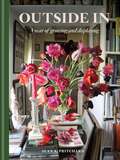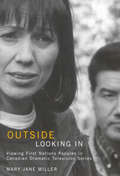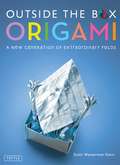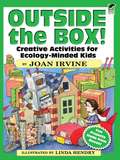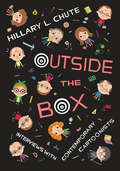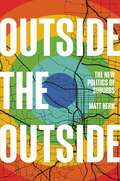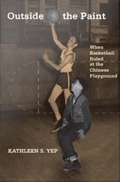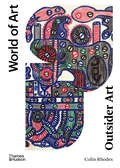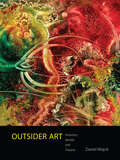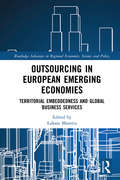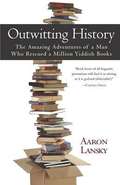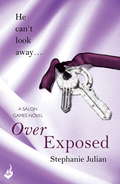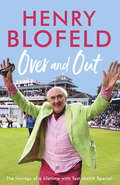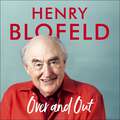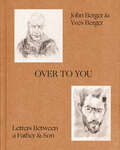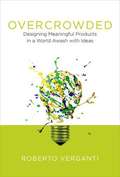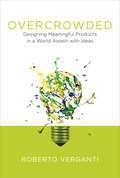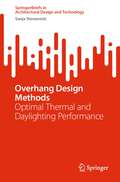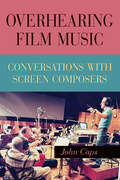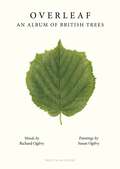- Table View
- List View
Outside In: A Year of Growing & Displaying
by Sean A Pritchard'Inventive, considered, and thoughtful design.' House & GardenIn his debut book, garden designer Sean A Pritchard shows you how to plan a garden so that every month of the year there's something to bring indoors and display in an engaging way. From the cheery joy of early spring daffodils to the velvety richness of late-summer dahlias, the deep glow of golden autumn leaves to the optimism of late-winter catkins, Sean explains how to grow, harvest, and arrange an abundance of nature's treasure - no matter the size of your plot or your level of horticultural experience.
Outside Looking In
by Mary Jane MillerUsing recent scholarship in ethnography and popular culture, Miller throws light on both what these series present and what is missing, how various long-standing issues are raised and framed differently over time, and what new issues appear. She looks at narrative arc, characterization, dialogue, and theme as well as how inflections of familiar genres like family adventure, soap opera, situation comedy, and legal drama shape both the series and viewers' expectations. Miller discusses Radisson, Forest Rangers and other children's series in the 1960s and early 1970s, as well as Beachcombers, Spirit Bay, The Rez, and North of 60 - series whose complex characters created rewarding relationships while dealing with issues ranging from addiction to unemployment to the aftermath of the residential school system.
Outside Looking In: Viewing First Nations Peoples in Canadian Dramatic Television Series (McGill-Queen's Indigenous and Northern Studies #154)
by Mary Jane MillerUsing recent scholarship in ethnography and popular culture, Miller throws light on both what these series present and what is missing, how various long-standing issues are raised and framed differently over time, and what new issues appear. She looks at narrative arc, characterization, dialogue, and theme as well as how inflections of familiar genres like family adventure, soap opera, situation comedy, and legal drama shape both the series and viewers' expectations. Miller discusses Radisson, Forest Rangers and other children's series in the 1960s and early 1970s, as well as Beachcombers, Spirit Bay, The Rez, and North of 60 - series whose complex characters created rewarding relationships while dealing with issues ranging from addiction to unemployment to the aftermath of the residential school system.
Outside the Box
by Gail AndersonIn an age of slick, computer-generated type and Photoshopped perfection, hand-drawn packing is enjoying a global resurgence. As shorthand for something more authentic, homegrown, handmade, or crafted, hand-drawn packaging is found on everything from supermarket eggs to Chipotle drink cups. In this exhaustive and lavishly illustrated survey, organized by four types--DIY, art, craft, and artisanal--Gail Anderson pulls back the curtain on the working processes and inspirations of forty letterers, illustrators, and designers from all around the world through insightful interviews, process sketches, and her infectious love of the medium.
Outside the Box Origami: A New Generation of Extaordinary Folds
by Scott Wasserman SternTake your paper folding to the next level with this creative, dynamic origami book.Join origami paper craft whiz Scott Wasserman Stern on a journey beyond the usual with Outside the Box Origami. <P><P>Begun by the author at age fourteen and the product of three years of work, this extraordinary paper craft book contains 20 original, whimsical paper fold projects ranging from the simple to the complex.Outside the Box Origami features a mix of single-sheet and modular origami models accompanied by full-colored photos, illustrations and easy-to-follow diagrams. A variety of different folds are featured--from the geometric models like the "Starburst" to more adventurous and organic models such as "When Pigs Fly!" The book culminates with "Folding Outside the Box" a challenging single-sheet model that depicts two hands reaching out of a box, folding a piece of origami paper.If you're looking for a more modern and contemporary version of origami, this papercraft book is sure to wet your appetite!
Outside the Box!: Creative Activities for Ecology-Minded Kids (Dover Children's Activity Books)
by Linda Hendry Joan IrvineIf you've got a box, you've got it made! With step-by-step instructions and hundreds of illustrations, this book can help kids transform a cardboard box into easy-to-make playthings--and teach them firsthand about recycling. Start with the basics: a box and an imagination. Tissue boxes, cereal boxes, corrugated boxes, and cardboard boxes can all be put to good use. Then just follow directions for dozens of projects.The possibilities are endless! Thinking beyond the box, kids can make a puppet stage, sports car, propeller airplane, robot, tin man costume, moon suit, giant dragon, miniature golf game, musical box band, and much more. It all adds up to enjoying a fun day in an earth-friendly way--a creative, environmental lesson that kids will love!
Outside the Box: Interviews with Contemporary Cartoonists
by Hillary L. ChuteWe are living in a golden age of cartoon art. Never before has graphic storytelling been so prominent or garnered such respect: critics and readers alike agree that contemporary cartoonists are creating some of the most innovative and exciting work in all the arts. For nearly a decade Hillary L. Chute has been sitting down for extensive interviews with the leading figures in comics, and with Outside the Box she offers fans a chance to share her ringside seat. Chute’s in-depth discussions with twelve of the most prominent and accomplished artists and writers in comics today reveal a creative community that is richly interconnected yet fiercely independent, its members sharing many interests and approaches while working with wildly different styles and themes. Chute’s subjects run the gamut of contemporary comics practice, from underground pioneers like Art Spiegelman and Lynda Barry, to the analytic work of Scott McCloud, the journalism of Joe Sacco, and the extended narratives of Alison Bechdel, Charles Burns, and more. They reflect on their experience and innovations, the influence of peers and mentors, the reception of their art and the growth of critical attention, and the crucial place of print amid the encroachment of the digital age. Beautifully illustrated in full-color, and featuring three never-before-published interviews—including the first published conversation between Art Spiegelman and Chris Ware—Outside the Box will be a landmark volume, a close-up account of the rise of graphic storytelling and a testament to its vibrant creativity.
Outside the Outside: The New Politics of Suburbs
by Matt Hern"Matt Hern's brilliant and captivating Outside the Outside presents an urgently needed, theoretically sophisticated street-level perspective on some of the most pertinent ongoing critical debates about life and politics in our decentered suburban world."—Roger Keil, author of Suburban PlanetModern "sub-urbs" as a place of vibrancy, conflict and resistanceMatt Hern argues that the changing relationship between the urban center and the suburban periphery forces us to rethink the entire identity of the city itself. Today, most of the Western world lives on the city outskirts. Yet these neighborhoods that once offered security and respite from the perceived dangers of the city center have been radically transformed in the last few decades to poor, working-class and racialized communities. Outside the Outside maps these changes and argues for a revival of the social life of the city as a whole.Hern shows how language that relegates parts of the urban to the &“outside&” and designates other parts as the "center" echoes colonial forms of domination. This should come as no surprise in an era when communities are forced onto the periphery and beyond by gentrification.With on-the-ground reportage in, among other places, Vancouver, Portland, London, Ferguson and Rabat, Hern demonstrates how we need to challenge our misconceptions and see the "sub-urbs" as vibrant places of resistance and regeneration and to celebrate the movement, circulation and difference to be found there.
Outside the Paint: When Basketball Ruled at the Chinese Playground
by Kathleen S. YepThis fascinating book reveals that Chinese Americans began "shooting hoops" nearly a century before Chinese superstar Yao Ming turned pro. Drawing on interviews with players and coaches, Outside the Paint takes readers back to San Francisco in the 1930s and 1940s, when young Chinese American men and women developed a new approach to the game--with fast breaks, intricate passing and aggressive defense--that was ahead of its time. Every chapter tells a surprising story: the Chinese Playground, the only public outdoor space in Chinatown; the Hong Wah Kues, a professional barnstorming men's basketball team; the Mei Wahs, a championship women's amateur team; Woo Wong, the first Chinese athlete to play in Madison Square Garden; and the extraordinarily talented Helen Wong, whom Kathleen Yep compares to Babe Didrikson. Outside the Paintchronicles the efforts of these highly accomplished athletes who developed a unique playing style that capitalized on their physical attributes, challenged the prevailing racial hierarchy, and enabled them, for a time, to leave the confines of their segregated world. They learned to dribble, shoot, and steal.
Outsider Art (World of Art)
by Colin RhodesThe updated edition of this comprehensive overview of outsider art, distinguished by its wider international scope and inclusion of global developments since 2000. Outsider art is the work produced outside the mainstream of modern art by self-taught, untrained visionaries, spiritualists, recluses, folk artists, psychiatric patients, prisoners, and others beyond the imposed margins of society and the art market. Coined by Roger Cardinal in 1972, the term was intended as an English equivalent to Jean Dubuffet’s "art brut"—literally "raw art," "uncooked" by culture, unaffected by fashion, unmoved by artistic standards. In this comprehensive and indispensable guide, Colin Rhodes surveys the history and reception of outsider art—first championed by Dubuffet and the Surrealists, now appreciated by a wider public. This volume provides fresh insights into the achievements of both major figures and newly discovered artists, as well as the emergence of specialized studios, as the relationship between outsider art and the contemporary mainstream art world has developed and become more intertwined. From spirit-guided Madge Gill and schizophrenic Adolf Wölfli, to Rosemarie Koczÿ’s expressions of trauma and Nek Chand’s outdoor creations, these individuals passionately pursue the pictorial expression of their vision. Now illustrated in full color, with the exception of some archival photographs, this new edition has been substantially revised with a greater focus on global outsider art, as well as including more recent talents to the field.
Outsider Art: Visionary Worlds and Trauma
by Daniel WojcikOutsider art has exploded onto the international art scene, gaining widespread attention for its startling originality and visual power. As an expression of raw creativity, outsider art remains associated with self-taught visionaries, psychiatric patients, trance mediums, eccentric outcasts, and unschooled artistic geniuses who create things outside of mainstream artistic trends and styles. Outsider Art: Visionary Worlds and Trauma provides a comprehensive guide through the contested terrain of outsider art and the related domains of art brut, visionary art, “art of the insane,” and folk art. The book examines the history and primary issues of the field as well as explores the intersection between culture and individual creativity that is at the very heart of outsider art definitions and debates. Daniel Wojcik's interdisciplinary study challenges prevailing assumptions about the idiosyncratic status of outsider artists. This wide-ranging investigation of the art and lives of those labeled outsiders focuses on the ways that personal tragedies and suffering have inspired the art-making process. In some cases, trauma has triggered a creative transformation that has helped artists confront otherwise overwhelming life events. Additionally, Wojcik's study illustrates how vernacular traditions, religious worldviews, ethnic heritage, and popular culture have influenced such art. With its detailed consideration of personal motivations, cultural milieu, and the potentially therapeutic aspects of art making, this volume provides a deeper understanding of the artistic impulse and human creativity.
Outsourcing in European Emerging Economies: Territorial Embeddedness and Global Business Services (Routledge Advances in Regional Economics, Science and Policy)
by Łukasz MamicaDrawing on a range of European cases, this edited volume analyses the offshoring and outsourcing of foreign companies, with a focus on territorial embeddedness. The book opens by developing a theoretical framework and then presents a range of international case studies exploring the experiences of the service hub cities of Brno, Bratislava, Budapest, Krakow, and Prague. Attention is also given to internal and external determinants of embeddedness, with chapters on the employee perspective, the Fintech industry, corporate social responsibility, and the role of universities. This volume will be of interest to advanced students and researchers in regional economics, economic geography, innovation studies, industrial economics, European economics, and international business.
Outstanding Mini Albums: 50 Ideas for Creating Mini Scrapbooks
by Jessica AcsThe Best Things Come in Small Packages Big memories don't require big pages. You can showcase your most important moments in irresistible, adorable mini scrapbooks! Outstanding Mini Albumsis filled with inspiration, ideas and instructions for creating mini scrapbooks of all kinds, from cleverly embellished store-bought albums to books made completely from scratch. Fifty fabulous illustrated projects show you how mini albums are perfect for scrapping lots of photos quickly, displaying your memories around the house, and giving as one-of-a-kind gifts. Step by step, you'll learn to: Make pre-made albums all your own with fun themes and original embellishments. Reinvent everyday items like coffee cups and CDs as pages for handmade mini books. Master new techniques, like crafting faux epoxy letters and homemade buttons. Give your creativity a mini makeover! When a scrapbook page seems too small but a whole album seems too big,Outstanding Mini Albumswill help you get it just right.
Outwitting History: The Amazing Adventures of a Man Who Rescued a Million Yiddish Books
by Aaron LanskyThe great Yiddish scholar Max Weinreich was delivering a lecture in Finland when the Nazis invaded his native Poland. The lecture saved his life. He made his way to New York, where he opened his doors to new students. Many thought his work was hopeless - especially since half of the world's Yiddish speakers had been killed in the Holocaust. Asked why he persevered, Weinreich answered simply: "Because Yiddish has magic, it will outwit history." And so it has, though in ways few could have imagined. In 1980, a twenty-three-year-old student named Aaron Lanksy set out to rescue the world's abandoned Yiddish books before it was too late. Precious volumes that had survived Hitler and Stalin were being passed down from older generations of Jewish immigrants to their non-Yiddish-speaking children, only to be thrown away or destroyed. With little more than his own chutzpah, Lansky issued a worldwide appeal for unwanted Yiddish books, and the response was overwhelming. Outwitting History is an adventure tale filled with unforgettable characters and told with the exuberance of a man whose passion led him from house to house, country to country, collecting treasured books and heartfelt, often hilarious stories of the vibrant intellectual world these older Jews inhabited. Lansky and a team of young volunteers crisscrossed America, schlepping books from attics and basements, demolition sites and Dumpsters one book at a time, their beloved literary history. When Lansky started out, experts believed that fewer than 70,000 Yiddish-language books still existed. Twenty-five years and 1.5 million books later, the organization Lansky founded, the National Yiddish Book Center, is one of the largest and fastest-growing Jewish cultural groups in the world. As he takes us along on his groundbreaking journey, Lansky explores the roots of the Yiddish language and introduces us to the brilliant Yiddish writers, from Mendele to Sholem Aleichem to I.B. Singer, whose lasting cultural relevance is evident on every page. He shares the humor, tenacity, and love for the written word that unites Jewish immigrants with everyone who cares about the future of great literature. And he enables us to see how an almost-lost culture is the bridge between the old world and the future. Includes discussion questions and activities.
Over Exposed: Salon Games Book 3 (Salon Games)
by Stephanie JulianStephanie Julian once again delivers heart with heat in the latest installment of her Salon Games series. For fans of E. L. James, Sylvia Day, J. Kenner and Beth Kery.When the cameras are off, the real action begins...and he can't look away.Greg Hicks is a Hollywood power player. For years he's enjoyed the perks that come with being a top director and producer: the influence, the wealth...the women. But none of his many conquests have ever possessed the incredible sensuality of the young woman he once watched lose all inhibition in front of his camera. Sabrina Rodriquez's life is far from a Hollywood dream. Refusing to make the same mistakes as her unlucky-in-love mother, she's focused on her first real job and avoiding all distractions, especially those of the male variety. Yet a man as compelling as Greg is difficult to ignore. And the desires he awakens are even harder to quench...Don't miss the erotically charged first installments in the Salon Games series, By Private Invitation and No Reservations.
Over and Out: Memories of Test Match Special from a broadcasting icon
by Henry BlofeldFor over half a century, Henry Blofeld has conveyed his unfailing enthusiasm for the game of cricket as a much loved broadcaster and journalist. His characteristically patrician tones, overlaid with those of the bon viveur, have delighted listeners to the BBC's Test Match Special where the personality of the broadcaster comes second only to a deep knowledge of the game and its players. With his engaging conversational tone it is easy to see why listeners feel as if they are actually at the Test match watching in Henry's friendly company. Now that 'Blowers' has decided to declare his TMS innings closed, his book reveals the secrets of life in the commentary box and of the rich cast of characters with whom he shared it, from the early days of John Arlott and Brian Johnson to Aggers and new boys Boycott, Swann, Vaughan and Tuffers. Henry is equally revealing of his own performances and self-deprecatingly recalls his several verbal misfortunes while live broadcasting. Like the greatest commentators and writers on the game Blofeld has always understood that there is a world beyond the cricket field. Not forgetting pigeons passing, red buses and much loved cricket grounds, Henry Blofeld writes of his favourite countries, and experiences while travelling, and meeting and interviewing many cricket-loving celebrities. His passionate and entertaining book will become one of the classics of cricket's literature.
Over and Out: Memories of Test Match Special from a broadcasting icon
by Henry BlofeldFor over half a century, Henry Blofeld has conveyed his unfailing enthusiasm for the game of cricket as a much loved broadcaster and journalist. His characteristically patrician tones, overlaid with those of the bon viveur, have delighted listeners to the BBC's Test Match Special where the personality of the broadcaster comes second only to a deep knowledge of the game and its players. With his engaging conversational tone it is easy to see why listeners feel as if they are actually at the Test match watching in Henry's friendly company. Now that 'Blowers' has decided to declare his TMS innings closed, his book reveals the secrets of life in the commentary box and of the rich cast of characters with whom he shared it, from the early days of John Arlott and Brian Johnson to Aggers and new boys Boycott, Swann, Vaughan and Tuffers. Henry is equally revealing of his own performances and self-deprecatingly recalls his several verbal misfortunes while live broadcasting. Like the greatest commentators and writers on the game Blofeld has always understood that there is a world beyond the cricket field. Not forgetting pigeons passing, red buses and much loved cricket grounds, Henry Blofeld writes of his favourite countries, and experiences while travelling, and meeting and interviewing many cricket-loving celebrities. His passionate and entertaining book will become one of the classics of cricket's literature.
Over and Out: My Innings of a Lifetime with Test Match Special
by Henry BlofeldFor over half a century, Henry Blofeld has conveyed his unfailing enthusiasm for the game of cricket as a much loved broadcaster and journalist. His characteristically patrician tones, overlaid with those of the bon viveur, have delighted listeners to the BBC's Test Match Special where the personality of the broadcaster comes second only to a deep knowledge of the game and its players. With his engaging conversational tone it is easy to see why listeners feel as if they are actually at the Test match watching in Henry's friendly company. Now that 'Blowers' has decided to declare his TMS innings closed, his book reveals the secrets of life in the commentary box and of the rich cast of characters with whom he shared it, from the early days of John Arlott and Brian Johnson to Aggers and new boys Boycott, Swann, Vaughan and Tuffers. Henry is equally revealing of his own performances and self-deprecatingly recalls his several verbal misfortunes while live broadcasting. Like the greatest commentators and writers on the game Blofeld has always understood that there is a world beyond the cricket field. Not forgetting pigeons passing, red buses and much loved cricket grounds, Henry Blofeld writes of his favourite countries, and experiences while travelling, and meeting and interviewing many cricket-loving celebrities. His passionate and entertaining book will become one of the classics of cricket's literature.
Over to You: Letters Between a Father and Son
by John Berger Yves BergerCompelling and intimate, this collection of never-before-seen letters between the celebrated art critic and essayist, John Berger and his son Yves, an artist, is a moving look at their musings on art, memory, life, death, and beyond.Written between 2015-16, with 53 color images of well-known old masters and contemporary art as well as some of the Bergers&’ own drawings and watercolors, Over to You is an informal back and forth not unlike the ping-pong games father and son used to play in the barn of their house. It begins when John—who is in a Parisian suburb—sends Yves—who is in Haute Savoie—an envelope of reproductions of art that have moved him. And so they begin to reveal their thoughts looking at a Goya, Watteau, Twombly, Joan Mitchell, Durer, Caravaggio, Manet, and Euan Uglow, among many others. But the art is just a way to summon shared emotions and memories, as well as deepen their understanding of the world and its mysteries.John at 89 is the more formal teacher, Yves at 39 comes across as the younger, philosophical artist. There are John&’s thoughts on the use of color, light and space in, say, a Dürer, or a Beckmann to the question of &“staying fully alive&”; or Yves noting how much in life exceeds our understanding, the gap between our consciousness and our feeling, between the said and the unsaid. &“That&’s the zone where I would like us to meet. Are you coming?&” He asks his father. &“I may need other eyes to confirm what is really there. Like your eyes always did.&” This is an exceptional and moving tribute to a relationship between a father and son, and between two artists, as well as a thought provoking look at questions we all have about work, time, the universe, life and death.
Overbrook Farms
by The Overbrook Farms ClubRailroad capitalists founded Overbrook Farms in 1892 as the first planned community along the main line of the Pennsylvania Railroad. The partners envisioned and developed a new community model on farmland purchased from the John M. George estate. Visionary and innovative amenities included independent on-site steam-heat plants and a dedicated water supply. The grand homes were built in a range of styles designed by some of America's most celebrated architects. Overbrook Farms' name derives from the stream that originally flowed under the tracks of the Overbrook train station. Today, Overbrook Farms is a residential neighborhood in Philadelphia and is listed in the National Register of Historic Places. More than 100 years later, nearly all of the 400-plus original Overbrook Farms structures remain intact through the efforts of the community as well as those of the Overbrook Farms Club, America's oldest continually operating neighborhood association.
Overcrowded: Designing Meaningful Products in a World Awash with Ideas
by Roberto VergantiThe standard text on innovation advises would-be innovators to conduct creative brainstorming sessions and seek input from outsiders -- users or communities. This kind of innovating can be effective at improving products but not at capturing bigger opportunities in the marketplace. In this book Roberto Verganti offers a new approach -- one that does not set out to solve existing problems but to find breakthrough meaningful experiences. There is no brainstorming -- which produces too many ideas, unfiltered -- but a vision, subject to criticism. It does not come from outsiders but from one person's unique interpretation. The alternate path to innovation mapped by Verganti aims to discover not how things work but why we need things. It gives customers something more meaningful -- something they can love. Verganti describes the work of companies, including Nest Labs, Apple, Yankee Candle, and Philips Healthcare, that have created successful businesses by doing just this. Nest Labs, for example, didn't create a more advanced programmable thermostat, because people don't love to program their home appliances. Nest's thermostat learns the habits of the household and bases its temperature settings accordingly. Verganti discusses principles and practices, methods and implementation. The process begins with a vision and proceeds through developmental criticism, first from a sparring partner and then from a circle of radical thinkers, then from external experts and interpreters, and only then from users. Innovation driven by meaning is the way to create value in our current world, where ideas are abundant but novel visions are rare. If something is meaningful for both the people who create it and the people who consume it, business value follows.
Overcrowded: Designing Meaningful Products in a World Awash with Ideas (Design Thinking, Design Theory)
by Roberto VergantiA more powerful innovation, which seeks to discover not how things work but why we need things. The standard text on innovation advises would-be innovators to conduct creative brainstorming sessions and seek input from outsiders—users or communities. This kind of innovating can be effective at improving products but not at capturing bigger opportunities in the marketplace. In this book Roberto Verganti offers a new approach—one that does not set out to solve existing problems but to find breakthrough meaningful experiences. There is no brainstorming—which produces too many ideas, unfiltered—but a vision, subject to criticism. It does not come from outsiders but from one person's unique interpretation. The alternate path to innovation mapped by Verganti aims to discover not how things work but why we need things. It gives customers something more meaningful—something they can love. Verganti describes the work of companies, including Nest Labs, Apple, Yankee Candle, and Philips Healthcare, that have created successful businesses by doing just this. Nest Labs, for example, didn't create a more advanced programmable thermostat, because people don't love to program their home appliances. Nest's thermostat learns the habits of the household and bases its temperature settings accordingly.Verganti discusses principles and practices, methods and implementation. The process begins with a vision and proceeds through developmental criticism, first from a sparring partner and then from a circle of radical thinkers, then from external experts and interpreters, and only then from users.Innovation driven by meaning is the way to create value in our current world, where ideas are abundant but novel visions are rare. If something is meaningful for both the people who create it and the people who consume it, business value follows.
Overhang Design Methods: Optimal Thermal and Daylighting Performance (SpringerBriefs in Architectural Design and Technology)
by Sanja StevanovicIt is estimated that windows in office buildings are responsible for one third of energy used for their heating and cooling. Designing window shading that balances often contradictory goals of preventing excessive heat gains in hot periods, without compromising beneficial heat gains in cold periods or visual comfort in indoor spaces of modern buildings with highly glazed facades, is an interesting multi-objective optimisation problem that represents an active research topic in the field of building energy and daylighting. Window overhangs are the simplest and most traditional shading devices that are easy to install, highly cost-effective, require low or no maintenance and offer unobstructed views outside. This book provides a review of overhang design methods for optimal thermal and daylighting performance. It starts with a historical overview of methods based on solar positions and shading masks. Next it discusses current research methodology, including shading calculation methods, ways of quantifying thermal and daylighting overhang effectiveness and the use of multi-objective optimisation approaches, together with the case studies that employ them. It further covers methods for designing innovative overhang types such as NURBS outlined overhangs and PV integrated dynamic overhangs. The appendix classifies published overhang case studies according to major climate type and latitude of their locations. As such, the book presents a valuable resource for understanding subtle nuances of interaction between solar radiation, shading devices and indoor comfort. The intended target audience are building energy researchers interested in optimisation of window shading devices.
Overhearing Film Music: Conversations with Screen Composers (SUNY series, Horizons of Cinema)
by John CapsBeginning with a quick history of film scoring and then taking the reader backstage to interview a dozen major screen composers, Overhearing Film Music represents three generations of movie soundtrack music. Ranging from groundbreaking composers who scored classic 1940s melodramas such as Laura and the Thief of Bagdad, to the jazz-influenced modernists who worked on Rebel Without a Cause and The Pink Panther, and into the symphonic renaissance represented by films like Star Wars and Harry Potter, Caps asks the seminal questions: How did this kind of active movie scoring evolve from silent films—and where is it headed? These interviews provide a master class in how and why to score a film. Interspersed among the interviews, Caps's single-subject essays provide concise histories of the use of choral music in films, African American and female film composers, and digital composing software for a new era.
Overleaf: An Album of British Trees
by Richard OgilvyAn illustrated natural history of British native trees, by a celebrated botanical artist and her forester brother-in-lawOur trees are among our greatest national treasures, and yet today many people have forgotten their names, their identifying features and the stories we used to tell about them. In Overleaf, the botanical painter Susan Ogilvy and the forester Richard Ogilvy reacquaint us with the trees of the British Isles through careful study of their leaves. From the water-loving alder to the long-lived yew, Susan paints every tree's leaf or needle in exquisite, jewel-like detail, at exactly life size, while Richard explores their natural history, the landscapes they inhabit and the ways we use their timber, leaves, flowers and fruit in craft, industry, food and medicine. As vivid and true to life as a book of freshly picked and pressed leaves, Overleaf will delight and inform tree-spotting beginners and seasoned naturalists alike.
